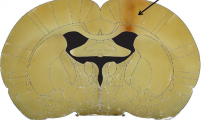Abstract
The purpose of the present study was to clarify the central nervous system function of amino acids during acute stress. In Experiment 1, changes in free amino acid pattern were investigated in the brain of neonatal chicks exposed to either restraint with isolation-induced or fasting stress. l-Proline and l-arginine were decreased in the telencephalon and diencephalon under any stress. Since the central nervous system functions of l-arginine during the stress response has recently been reported, in Experiment 2, the effect of intracerebroventricular injection of l-proline (0.5, 1.0, 2.0 μmol) during isolation-induced stress was investigated. l-Proline induced sedative and hypnotic effects in a dose-dependent manner. It is suggested that l-proline may have an important role to attenuate the stress response in the central nervous system of chicks.

Similar content being viewed by others
References
Asechi M, Tomonaga S, Tachibana T, Han L, Hayamizu K, Denbow DM, Furuse M (2006) Intracerebroventricular injection of l-serine analogs and derivatives induces sedative and hypnotic effects under an acute stressful condition in neonatal chicks. Behav Brain Res 170:71–77
Asechi M, Kurauchi I, Tomonaga S, Yamane H, Suenaga R, Tsuneyoshi Y, Denbow DM, Furuse M (2008) Relationships between the sedative and hypnotic effects of intracerebroventricular administration of l -serine and its metabolites, pyruvate and the derivative amino acids contents in the neonatal chicks under acute stressful conditions. Amino Acids 34:55–60
Baquet A, Lavoinne A, Hue L (1991) Comparison of the effects of various amino acids on glycogen synthesis, lipogenesis and ketogenesis in isolated rat hepatocytes. J Biochem 273:57–62
Boehning D, Snyder SH (2003) Novel neural modulators. Annu Rev Neurosci 26:105–131
Davis JL, Masuoka DT, Gerbrandt LK, Cherkin A (1979) Autoradiographic distribution of l-proline in chicks after intracerebral injection. Physiol Behav 22:693–695
Feltenstein MW, Lambdin LC, Ganzera M, Ranjith H, Dharmaratne W, Nanayakkara NP (2003) Anxiolytic properties of Piper methysticum extract samples and fractions in the chick social-separation-stress procedure. Phytother Res 17:210–216
Henzi V, Reichling DB, Helm SW, Macdermott AB (1992) l-Proline activates glutamate and glycine receptors in cultured rat dorsal horn neurons. Mol Pharmacol 41:793–801
Hu CA, Phang JM, Valle D (2008) Proline metabolism in health and disease. Amino Acids (in press)
Kurauchi I, Asechi M, Tachibana T, Han L, Hayamizu K, Denbow DM, Furuse M (2006) Intracerebroventricular injection of l-alanine induces a sedative effect under an acute stressful condition in neonatal chicks. J Poult Sci 43:384–387
Kurauchi I, Yamane H, Tsuneyoshi Y, Denbow DM, Furuse M (2008) Central l-alanine reduces energy expenditure with a hypnotic effect under an acute stressful condition in neonatal chicks. Amino Acids (in press)
Nishibori M, Oishi R, Itoh Y, Saeki K (1986) Glucose modulates the release of histamine from the mouse hypothalamus in vitro. J Neurochem 47:1761–1767
Ottersen OP, Zhang N, Walberg F (1992) Metabolic compartmentation of glutamate and glutamine: morphological evidence obtained by quantitative immunocytochemistry in rat cerebellum. Neuroscience 46:519–534
Panksepp J, Bean NJ, Bishop P, Vilberg T, Sahley TL (1980) Opioid blockade and social comfort in chicks. Pharmacol Biochem Behav 13:673–683
Rubio LA (2003) Determination of diaminopimelic acid in rat feces by high-performance liquid chromatography using the Pico Tag method. J chromatogr B 784:125–129
Sahley TL, Panksepp J, Zolovick AJ (1981) Cholinergic modulation of separation distress in the domestic chick. Eur J Pharmacol 72:261–264
Sakata T, Kurokawa M, Oohara A, Yoshimatsu H (1994) A physiological role of brain histamine during energy deficiency. Brain Res Bull 35:135–139
Snyder SH, Young AB, Bennett JP, Mulder AH (1973) Synaptic biochemistry of amino acids. Fed Proc 32:2039–2047
Suenaga R, Tomonaga S, Yamane H, Kurauchi I, Tsuneyoshi Y, Sato H, Denbow DM, Furuse M (2008a) Intracerebroventricular injection of l-arginine induces sedative and hypnotic effects under an acute stress in neonatal chicks. Amino Acids 35:139–146
Suenaga R, Yamane H, Tomonaga S, Asechi M, Adachi N, Tsuneyoshi Y, Kurauchi I, Sato H, Denbow DM, Furuse M (2008b) Central l-arginine reduced stress responses are mediated by l-ornithine in neonatal chicks. Amino Acids 35:107–113
Sugden MC, Watts DI, West PS, Palmer TN (1984) Proline and hepatic lipogenesis. Biochimica Biophys Acta 798:368–373
Takemoto Y (2005) Depressor responses to l-proline microinjected into the rat ventrolateral medulla are mediated by ionotropic excitatory amino acid receptors. Auton Neurosci-Basic 120:108–112
Tomonaga S, Tachibana T, Takagi T, Saito E, Zhang R, Denbow DM, Furuse M (2004) Effect of central administration of carnosine and its constituents on behaviors in chicks. Brain Res Bull 63:75–82
Van Luijtelaar ELJM, van der Grinten CPM, Blokhuis HJ, Coenen AML (1987) Sleep in the domestic hen (Gallus domesticus). Physiol Behav 41:409–414
Acknowledgments
This work was supported by a Grant-in-Aid for Scientific Research from Japan Society for the Promotion of Science (No. 18208023) and the SKYLARK Food Science Institute. The authors are grateful to the staffs and students of Laboratory of Chemistry and Technology of Animal Products in Kyushu University for their assistance in analysis of amino acids.
Author information
Authors and Affiliations
Corresponding author
Rights and permissions
About this article
Cite this article
Hamasu, K., Haraguchi, T., Kabuki, Y. et al. l-Proline is a sedative regulator of acute stress in the brain of neonatal chicks. Amino Acids 37, 377–382 (2009). https://doi.org/10.1007/s00726-008-0164-0
Received:
Accepted:
Published:
Issue Date:
DOI: https://doi.org/10.1007/s00726-008-0164-0



